Building for the future
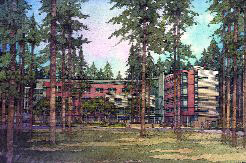 Numerous construction projects
are about to commence, already under way, or nearly completed on campus.
The major projects, which will result in new housing, classrooms, office, and research space, include the following: the Physical Sciences Building (depicted in an artist's rendering, above), to be completed in fall 2003; the Core West Parking Structure, providing space for approximately 500 vehicles in the Science Hill area; the Interdisciplinary
Sciences Building, to be completed this fall; the Center for Adaptive Optics,
to be completed this fall; Bay Tree Bookstore and Graduate Student Commons,
ready for occupancy this spring; and residence halls for Colleges Nine and
Ten, which will provide on-campus housing for 800 students by fall 2002. Photo: Al Forster Numerous construction projects
are about to commence, already under way, or nearly completed on campus.
The major projects, which will result in new housing, classrooms, office, and research space, include the following: the Physical Sciences Building (depicted in an artist's rendering, above), to be completed in fall 2003; the Core West Parking Structure, providing space for approximately 500 vehicles in the Science Hill area; the Interdisciplinary
Sciences Building, to be completed this fall; the Center for Adaptive Optics,
to be completed this fall; Bay Tree Bookstore and Graduate Student Commons,
ready for occupancy this spring; and residence halls for Colleges Nine and
Ten, which will provide on-campus housing for 800 students by fall 2002. Photo: Al Forster
The mystery behind the vanishing fur seal
| |
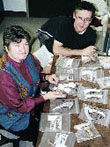
Anthropologist Diane Gifford-Gonzalez, left, and geochemist Paul Koch have teamed up to study northern fur seals (below).
Photo: Jennifer McNulty
|
| |
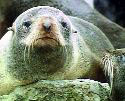
Photo:
Kimberlee B. Beckmen |
For years, anthropologist Diane Gifford-Gonzalez was pestered by nagging
questions about some marine mammal bones that were part of UCSC's extensive
archaeological archive. Why, she wondered, did the collection contain the
remains of so many northern fur seals, a species that today is found primarily
off Siberia and the Aleutian Islands in Alaska?
The northern fur seal, one of the smallest of the eared seals, accounts
for fewer than 1 percent of all pinniped strandings along the Central Coast
today. But the presence of its bones accounted for about one-third of all sea mammals in local archaeological sites. Gifford-Gonzalez and Paul Koch, an associate professor of Earth sciences,
have teamed up to determine why the distribution of marine mammals around
the Monterey Bay Area has undergone such dramatic changes in the past 2,000
years.
Northern fur seals are perhaps best known for their fur, which was prized
by hunters in the 1800s. Long before the coming of the fur trade, however,
something made the seals vanish from mainland beaches along the Central
Coast. Gifford-Gonzalez and Koch have ruled out the usual suspects: bears,
coyotes, and other carnivores. More likely, they believe, would be human overpredation or climate change–or
a combination of the two. A small-scale pilot study they have conducted into the mystery has attracted
support from the National Science Foundation.
With NSF funding, Gifford-Gonzalez and Koch plan to pinpoint the date of the seal's disappearance and fill in details of the
environmental record.
UCSC faculty endorses 'narratives' and grades
UCSC's academic senatein November reaffirmed its commitment to the campus's long-standing Narrative Evaluation System (NES). In a special session
of the senate, faculty rejected a proposal that would have made the writing
of "narratives" optional.
The outcome drew a thunderous ovation from the students who were able
to squeeze into the lecture hall and from the dozens more who listened to
the proceedings via a speaker system set up outside.
"We're doing some things right at UCSC, and part of what we're doing
right is the NES," noted professor of linguistics James McCloskey.
The meeting brought to a close 12 months of senate discussion about the manner in which UCSC will assess the performance of future students.
As a result of the pro-NES vote–and a vote on letter grades that was
finalized only a month earlier–students who enter UCSC this coming fall will receive letter grades in most of their courses and narratives in all of them.
In a separate vote, senators also overwhelmingly endorsed an NES reform resolution authored by Professors Barbara Rogoff and William Ladusaw that, among other things, asked a senate committee to draft guidelines for the writing of narratives and requested administrative support for software that would ease the workload associated with the NES.
Campus enrollment tops 12,000 students
Enrollment at ucsc totaled 12,124 in the fall quarter. The growth mirrors what's happening at campuses statewide, as higher education systems gear up to serve an unprecedented number of new students in the state.
In the UC system alone, it is estimated that space will be needed for
63,000 additional academically eligible students by the year 2010. One scenario under discussion would have UCSC grow to 16,900 by the year
2010.
Endowment boosts Indian classical music
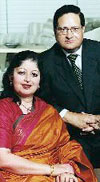 Jawab hamid ali khan, ruler of the state of Rampur, India, in the early
1900s, was well known for his love and patronage of the arts. Now, halfway around the world and three generations later, the great-granddaughter of this respected Nawab and her husband are carrying on that tradition, providing funding that will substantially expand the performance
and instruction of Indian classical music at UC Santa Cruz. Jawab hamid ali khan, ruler of the state of Rampur, India, in the early
1900s, was well known for his love and patronage of the arts. Now, halfway around the world and three generations later, the great-granddaughter of this respected Nawab and her husband are carrying on that tradition, providing funding that will substantially expand the performance
and instruction of Indian classical music at UC Santa Cruz.
The couple are Silicon Valley entrepreneurs Talat and Kamil Hasan of
Saratoga, California. Their gift of $350,000 establishes the Kamil and Talat
Hasan Endowed Chair in Classical Indian Music, which provides ongoing annual
support for UCSC's flourishing programs in Indian arts.
"Indian classical music is a remarkable art form," said Kamil Hasan. "It stands out from popular music because it not only pleases the mind and senses, it goes much deeper. It's important to us to do our part to keep this tradition flourishing."
Talat (seated) and Kamil Hasan
Photo: R. R. Jones
Extinct rhino behaved like modern hippo
Among the large mammals that roamed prehistoric North America was a type of rhinoceros that seems to have lived in the water, much like a modern hippopotamus. The extinct rhinoceros, known as Teleoceras, ranged
from Florida to the West Coast from about 17 million years ago until about
4.5 million years ago. Its semi-aquatic lifestyle, first suggested by its body shape, has been disputed by some researchers. But evidence preserved in fossil teeth now indicates that in some areas, at least, Teleoceras did spend much of its life in the water."Morphologically, Teleoceras looked a lot like modern hippos, with large, squat bodies and short legs, and we now have evidence from isotope analysis that they were semi-aquatic like hippos," said Mark Clementz,
a graduate student in Earth sciences, who presented his findings at a recent
meeting of the Geological Society of America.

An artist's rendering
of the Teleoceras habitat in Miocene Nebraska.
Art credit: University of Nebraska State Museum
Clementz and Paul Koch, an associate professor of Earth sciences, analyzed
oxygen isotopes in fossil Teleoceras teeth for clues to the animals' habits. Oxygen occurs in nature as three different isotopes. The two heavy isotopes are very rare (together they make up less than 0.5
percent of all oxygen atoms), but their greater mass has interesting consequences. Evaporation, for example, acts preferentially to remove water molecules containing the common, light isotope of oxygen.
The water left behind, whether in a puddle or in the body of an animal,
ends up with a higher proportion of heavy oxygen isotopes. The Teleoceras study grew out of work Koch had done on modern mammals in East Africa comparing different species within the same ecosystem.
New federal marine research facility dedicated
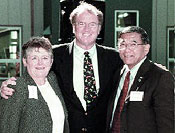 Congressman Sam Farr (center) and Norman Mineta, commerce secretary in the Clinton administration and President Bush's trans- portation
secretary-designate, joined Chancellor Greenwood for the dedication in October
of the new federal marine research facility next to UCSC's Long Marine Laboratory. In addition to conducting fisheries research, the new National Marine Fisheries Service Santa Cruz Laboratory
will house the nation's first National Science Center for Marine Protected
Areas. "Our oceans are indispensable lifelines from both environmental
and economic perspectives and require first-class research to ensure their
health," Mineta said. "This laboratory will provide researchers
with the critical tools they need to help shape the future of our oceans." Photo: Victor Schiffrin Congressman Sam Farr (center) and Norman Mineta, commerce secretary in the Clinton administration and President Bush's trans- portation
secretary-designate, joined Chancellor Greenwood for the dedication in October
of the new federal marine research facility next to UCSC's Long Marine Laboratory. In addition to conducting fisheries research, the new National Marine Fisheries Service Santa Cruz Laboratory
will house the nation's first National Science Center for Marine Protected
Areas. "Our oceans are indispensable lifelines from both environmental
and economic perspectives and require first-class research to ensure their
health," Mineta said. "This laboratory will provide researchers
with the critical tools they need to help shape the future of our oceans." Photo: Victor Schiffrin
Grant helps students 'gear up' for college
Students in the city of Watsonville will get a boost on their way to
college from UCSC, which has received a $3.7 million, five-year federal
grant to help disadvantaged students prepare for college.
The funding comes from the U.S. Department of Education's GEAR UP program,
which stands for Gaining Early Awareness and Readiness for Undergraduate
Programs. The mission of GEAR UP is to increase the number of low-income
students who are prepared to enter and succeed in postsecondary education.
The Educational Partnership Center at UCSC will administer the grant. The funding will support programs at Watsonville High School and its feeder middle schools.
UCSC is partner in new science institute
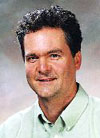 David Haussler David Haussler
Photo: UCSC photo service
UCSC will play a key role in
one of three new California
Institutes for Science and
Innovation established in
December by Governor Gray
Davis. The Institute for
Bioengineering, Biotechnology
and Quantitative Biomedical
Research (QB3) will be centered
at UC San Francisco with major
research components at UC
Santa Cruz and UC Berkeley.
The institute promises to
lead the next revolution in biomedical research. It will integrate
physical, mathematical,
and engineering sciences to create powerful new techniques for
attacking biological problems of
such enormous complexity that
they have simply remained unapproachable—until now. This
integration of sciences could
open the way for discovery of
treatments and cures for some
of our most intractable diseases,
such as brain disorders, cancer,
and diabetes.
One focus of QB3 will be
bioinformatics—computing
methods to sift through the volumes of data generated by the
human genome project and
other new developments in biomedical research. The institute's
bioinformatics program will be
based at UCSC.
"As experimental methods become more sophisticated and the
amount of data skyrockets, the
role for bioinformatics is dramatically expanding," said David
Haussler, UC Presidential
Professor of computer science at
UCSC and a codirector of the
institute. He and his colleagues
at UCSC have played a key role
in the Human Genome Project,
assembling the first publicly
available working draft of the
human genome sequence.
NASA Ames park is preferred site for Silicon Valley Center
Chancellor greenwood has announced that planning for UCSC's Silicon Valley
Center will focus on the proposed NASA Ames Research Park as the preferred
site for a permanent location. Further planning studies will lead to a final proposal to the Regents.
Among the criteria for siting the center are visibility, accessibility,
opportunity, net cost, and alignment with the teaching, research, and service mission of UCSC. Ames Research Center is one of ten field centers of NASA. The proposed site is part of a collaborative
R&D campus currently being developed by NASA Ames that includes a range of research,
education, and museum activities. UCSC's Silicon Valley Center would be
included on a parcel within the NASA Research Park, which is located adjacent
to the existing campus of the NASA Ames Research Center in Moffett Field.
"NASA's proposed R&D park fulfills the location criteria for
our Silicon Valley Center," Greenwood said. "NASA's innovative
vision for a research complex that emphasizes synergy among participants
is compatible with our campus's goals. Because of our existing research
collaborations with NASA Ames and numerous other educational partnerships
between UCSC and Silicon Valley institutions, we already have a strong foundation
on which we can develop further academic programs of benefit to the region."
The center is expected to serve as a portal to the UC system, connecting all of the campuses to Silicon Valley, especially in the areas of research. The University of California and NASA
share many research areas of interest and strengths, such as biotechnology,
nanotechnology, planetary sciences, and astro-biology. In addition, research is expected to be conducted on issues of social justice, education, labor, and economics, among other topics.
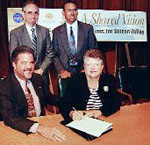 It is expected that UCSC will offer classes for both under-graduates and graduates at the Silicon Valley Center. The specific curricular offerings and subjects of research are to be determined through planning by faculty, which now is under way. It is expected that UCSC will offer classes for both under-graduates and graduates at the Silicon Valley Center. The specific curricular offerings and subjects of research are to be determined through planning by faculty, which now is under way.
The formation of a partnership to address
Silicon Valley's critical education and workforce needs was announced this
past fall by leaders from UC Santa Cruz, San Jose State University, Foothill-De Anza Community
College District, and NASA Ames Research Center. The "collaborative" envisions joint research and education programs among the institutions, to take place at the proposed NASA Research Park. Joining Chancellor Greenwood at a press conference announcing the partnership were Robert Caret (also seated), president of SJSU; Leo
Chavez (standing, right), chancellor of the community college district;
and NASA Ames Research Center director Henry McDonald. Photo: Greg Pio
UCSC's Academic Senate honors exemplary and inspiring teachers
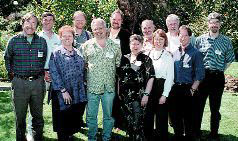 Each year, UCSC's Academic Senate honors
a number of the campus's most exemplary and inspiring teachers. Thirteen such professors and lecturers were chosen to receive Excellence in Teaching Awards
for 1999-2000. The recipients, above, were nominated by students for
qualities such as their enthusiasm for teaching, commitment to learning,
and the content of their courses. Photo: UCSC photo services Each year, UCSC's Academic Senate honors
a number of the campus's most exemplary and inspiring teachers. Thirteen such professors and lecturers were chosen to receive Excellence in Teaching Awards
for 1999-2000. The recipients, above, were nominated by students for
qualities such as their enthusiasm for teaching, commitment to learning,
and the content of their courses. Photo: UCSC photo services
Astronomers set sights on next telescope
The desire for ever larger telescopes has driven astronomers relentlessly for nearly 400 years. In 1610, Galileo discovered the moons of Jupiter using a telescope with a lens not much more than an inch in diameter.
Today, the largest optical telescopes are the twin Keck Telescopes in Hawaii,
with 10-meter mirrors that gather the faint light from distant galaxies.
But, of course, astronomers still want bigger telescopes, knowing they can
yield new insights into the nature and origins of the universe.
The next milestone in telescope size is likely to be one with a primary mirror 30 meters in diameter,
which would provide ten times the light-gathering area of each of the Kecks.
UC and the California Institute of Technology (Caltech) have teamed up to
design and build a 30-meter telescope, dubbed the California Extremely Large
Telescope (CELT). The project is still in the early planning stages, but
researchers led by UCSC astronomers are making steady progress on the conceptual
design for CELT.
Project leaders hope to build the massive telescope within the next ten to 15 years, said Joseph Miller, director of UC Observatories/Lick
Observatory (UCO/Lick). Miller estimated the total cost of t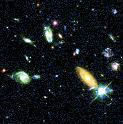 he project would
be around $500 million, but it's not clear yet where that money would come
from. he project would
be around $500 million, but it's not clear yet where that money would come
from.
Many of the distant objects revealed in the Hubble Deep Field, a revolutionary
image of deep space taken by the Hubble Space Telescope, are too faint for
detailed study with existing telescopes. With CELT, astronomers would be able to probe the faintest smudges of light in the
Hubble Deep Field, some of which may show the earliest stages of galaxy
formation in the universe.
Robert Williams, Hubble Deep Field Team; NASA
Please pass the caterpillar pie
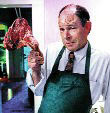 Dane Archershmuel Dane Archershmuel
Photo: Thaler/Santa Cruz Sentinel
Imagine a potluck buffet featuring fried spiders and rattlesnake. Sound yucky? Welcome to the world of food preferences, where
what is considered delicious–and disgusting–is more a matter of culture than most people think.
"People feel very strongly about what they will and won't eat,"
said sociologist Dane Archer. "Westerners cringe at the thought of
some Asian cultures that eat dog meat, because dogs are sacred in our culture.
But Hindus feel the same way about cows and are horrified by the 'dead animal'
racks in our supermarkets."
Food preferences and taboos are extremely emotional and value-laden,
said Archer. People tend to regard their own diet as sensible and the diets of other cultures as bizarre or irrational, all of which makes
food a "powerful way to teach about cultural diversity and tolerance," he said.
Archer, a professor of sociology at UCSC, has produced a new educational video about food, entitled A World of Food: Tastes and Taboos in Different Cultures. The engaging 35-minute
video features interviews with people from different cultures and undercuts
the dominant Western view that "what we eat is normal and what everybody
else eats is strange."
The video describes the prohibitions against certain foods in the major
religions of the world and presents a seven-rung food ladder, or "hierarchy
of eligible foods," that ranks what is considered edible, delicious,
and disgusting in various cultures.
Several new faces in campus administration
Four new deans have assumed positions within UCSC's senior administration this academic year.
Wlad Godzich, a department chair at the University of Geneva in Switzerland,
is the new dean of the Division of Humanities; Sung-Mo "Steve"
Kang, a department chair at the University of Illinois at Urbana- Champaign,
the dean of the Jack Baskin School of Engineering; Cathy Sandeen, an assistant
dean at UC San Francisco, the dean of University Extension/Summer Session;
and Frank Talamantes, of UCSC's Department of Molecular, Cell, and Develop-mental
Biology, has been named vice provost and dean of Graduate Studies.
Humanities gets boost in funding for center
This past october, more than 70 faculty, staff, and students gathered
at a Porter College courtyard for an inaugural celebration of UCSC's new Institute for Humanities Research (IHR).
The festive mood of the reception turned even more celebratory following surprise announcements of additional funding to the
center.
   
Clockwise, from upper left: Godzich, Kang,
Talamantes, and Sandeen
Photo credits (clockwise): UCSC photo services, UCSC photo services,
Chris T. Anderson, Titangos photography studio
Humanities Dean Wlad Godzich promised to earmark $60,000 over the next
three years to support a distinguished lecturer series and, in another surprise
announcement, Campus Provost and Executive Vice Chancellor John Simpson
pledged $38,000 to the IHR for graduate student support.
The IHR was created in 1999 to support humanities faculty and graduate student research and academic programming. The IHR is also the home of the internationally
renowned Center for Cultural Studies, one of the nation's premiere centers of interdisci-plinary research. IHR also supports Focused Research Activities in Feminism, Mind and Meaning, and
Pre- and Early Modern Studies (PEMS).
New map provides detailed views of UCSC
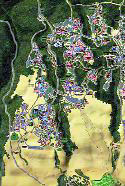 New campus map New campus map
Credit: Cherie Northon
A new map of ucsc has been unveiled that illustrates the campus with unprecedented clarity. The new campus map differs from its predecessors in several important ways: It is detailed enough to show all
paved pedestrian and bike paths, it shows the topography of the campus,
and it has been produced in color.
The map is available from the campus's Bay Tree Bookstore as a poster ($8.95) or as a folded map ($2) that includes insets for all of
UCSC's off-campus sites (including Long Marine Lab, Lick Observatory, the
Monterey Bay Education, Science, and Technology Center, and all UC Santa
Cruz Extension locations).
The map was created by cartographer Cherie Northon, who used existing maps, aerial photos, and fieldwork to check for accuracy.
The map was produced under the direction of UCSC's Office of Planning and Analysis. Funding was
also provided by a number of other offices: Housing, Transportation and Parking Services,
Admissions, Public Information, University Relations, the Division of Social
Sciences, and the Arboretum.
Economist funds grad student awards
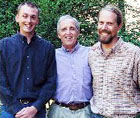 David kaun, a professor of economics at UCSC, has worked with some very
good graduate students over the years. But he was so impressed by two talented
teaching assistants that he has given the campus $50,000 to establish a new annual award that will recognize outstanding teaching by graduate students. David kaun, a professor of economics at UCSC, has worked with some very
good graduate students over the years. But he was so impressed by two talented
teaching assistants that he has given the campus $50,000 to establish a new annual award that will recognize outstanding teaching by graduate students.
At right: David Kaun, flanked by Matt McGinty (left) and Garrett Milam Photo: Jennifer
McNulty
Two graduate student recipients of the new Milam-McGinty-Kaun Award will be named each year:
one from the Economics Department and one from another department in the
Division of Social Sciences. Each will receive a $1,000 award. The award
is named after its first recipients, Garrett Milam and Matt McGinty, who are in UCSC's
doctoral program in international economics. Milam and McGinty were TAs
last year in Kaun's Intermediate Microeconomic Theory course, which had an enrollment
of about 120. "These two wonderful young men were phenomenal in every
dimension. They were so good, I just wanted to acknowledge that kind of teaching assistance."
Making science shockingly fun
Daniel greenhouse, a senior physics and math major, thinks learning about science should be fun.
He began experimenting with electricity when he was 12 years old, and before
long he was building Tesla coils that could generate huge arcs of electricity. This led to special-effects projects for concerts by the Grateful Dead and Phish bands.
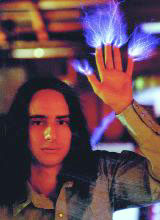 More recently, however, Greenhouse has helped a group of UCSC physics
faculty and local high school teachers develop a physics demonstration for
use in high school science classes. More recently, however, Greenhouse has helped a group of UCSC physics
faculty and local high school teachers develop a physics demonstration for
use in high school science classes.
The demonstration, involving such electrifying sights as a five-foot bolt of electricity striking
a person in a metal suit, is part of the educational outreach activities
of UCSC's Santa Cruz Institute for Particle Physics (SCIPP). The visual
spectacle of the exhibit provides an attention-grabbing context for teaching
a range of basic concepts about the power of electromagnetic fields. "I've always been interested in using electronic devices to get people
excited about science," Greenhouse said. "I love seeing someone's
eyes open wide in wonder."The demonstration was developed as part of SCIPP's summer research associates program, which brings high school teachers into the SCIPP labs for hands-on research experience. Teachers from local
schools in Santa Cruz and Watsonville were among those involved in the project, along with UCSC physics faculty and staff. The first public demonstration was held last July at Aptos High School's summer session. Hartmut Sadrozinski, adjunct professor
of physics and coordinator of SCIPP's summer research program, said the response has been tremendous. "You could
see from the expressions on the students' faces that they were really impressed."
He plans to bring the demonstration to other local high schools as well
as to schools in San Jose and San Francisco. At the heart of the demonstration is a Tesla coil, invented in the 1890s
by Nikola Tesla. Tesla's inventions include the alternating-current (AC) power system used to supply electrical power throughout
the world.
Daniel Greenhouse demonstrates one of the cool special effects–arcs
of electricity breaking out of his fingertips–that can be achieved with
a Tesla coil. Photo: courtesy of Daniel Greenhouse
Manganese exposure and Parkinson's
Anew study suggests that too much manganese, an essential element required
by the body in tiny amounts but toxic at elevated levels, may contribute
to the early development of Parkinson's disease symptoms in susceptible
people. Recent epidemiological studies have suggested an association between
Parkinson's disease and elevated exposure to manganese. The new study in
animals shows that exposure to low levels of manganese does not directly
contribute to the disease, but affects a different part of the brain in a way that exacerbates the effects
of Parkinson's.
UCSC researchers evaluated the effects of low-level exposure to manganese
using rats with a condition that mimics pre-Parkinsonism, an early stage of the disease
in which no symptoms are apparent. Their findings were published this past
fall in the scientific journal Neurotoxicology and Teratology.
The study highlights the importance of looking at the effects of toxic
substances on sensitive subsets of the population who may be most vulnerable,
said Donald Smith, an associate professor of environmental toxicology and
a coauthor of the paper.
"We are concerned about how chronic low-level exposures to toxic
substances may accelerate the emergence of neuro-degenerative diseases like Parkinson's," Smith said.
The possibility that people in the early stages of Parkinsonism could
be especially sensitive to moderately increased levels of manganese is disturbing,
he said. Manganese is ubiquitous in the environment, and its increasing
use in industrial processes may cause some people to take in greater amounts
from water, food, and airborne sources.
In addition, increased exposure to airborne manganese could result from
the use of the manganese compound MMT as a gasoline additive. Currently,
none of the major oil refineries are using MMT, but that could change, Smith
noted.
Alumni Association names award winners
|
A professor of women's studies, the national editor of the New York Times, and a UCSC staff member have been selected
to receive the highest awards bestowed annually by the UCSC Alumni Association.
Bettina Aptheker was given the Distinguished Teaching Award for her more
than 20 years of teaching and service; Katherine Roberts, national editor
of the New York Times, the Alumni Achievement Award, and David Kirk, who
has worked hard to expand the university's video and digital media collection, the Outstanding Staff Award.
The Alumni Council, the association's governing body, selected the winners
based on nominations from students, faculty, alumni, and staff. The three
recipients were honored on campus in early February. "In many of her
courses, Bettina incorporates art, poetry, guest speakers, slides, videos,
music and engaging readings," said Jorge Hankamer, former dean of humanities.
"She transforms each class experience into a multimedia chapter of
a well-planned story."
Roberts "represents the best of a Santa Cruz education," said
Alumni Council member Douglas Foster. Named national editor in November,
Roberts had been the newspaper's op-ed page editor since 1995, and had worked
in several other positions there. Roberts received a bachelor's in politics
from UCSC (Kresge '74). Outstanding Staff Award recipient Kirk's encylopedic
knowledge of film has placed him in a rare position for a nonacademic staff
member. In his more than 27 years at UCSC, Kirk has built a reputation as
someone who can track down the most obscure video, becoming a savior for
teachers who had nearly given up hope of finding just the right title for
their classes.
|
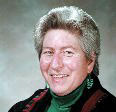
Bettina Aptheker
Photo: Don Harris
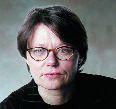
Katherine Roberts
Photo: New York Times
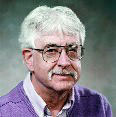
David Kirk
Photo: Don Harris
|
In Memoriam
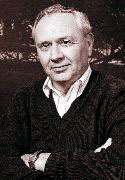 Ronald W. Henderson, a professor emeritus of education and psychology
at UCSC whose research focused on improving educational opportunities for underrepresented minorities, died at his Santa Cruz home in November
after a lengthy battle with melanoma. He was 67. Ronald W. Henderson, a professor emeritus of education and psychology
at UCSC whose research focused on improving educational opportunities for underrepresented minorities, died at his Santa Cruz home in November
after a lengthy battle with melanoma. He was 67.
Henderson's dual academic interests in child development and education
fueled his research on social and cultural influences on development, academic motivation, cognition, and mathematics and science education.
His specific research interest was in the development of instructional approaches that would increase achievement and participation
in mathematics by Latino students, women, and other groups that are under-represented in math and the sciences. He specialized in the development of motivation to achieve and participate in mathematics. Henderson, who joined the UC Santa Cruz faculty in 1977, also served as
provost of UCSC's Crown College, chair of the Academic Senate, and dean
of the Division of Graduate Studies.
His illness forced him to retire in 1999. Ronald Henderson Photo: Don Harris
|

